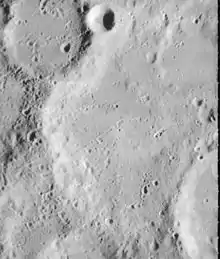Orontius (crater)
Orontius is a lunar impact crater that lies in the heavily cratered southern highlands of the Moon's near side. It was named after 16th century French mathematician Oronce Fine.[1] It is located to the northwest of the prominent ray crater Tycho, and south and east of the large walled plain Deslandres. The eastern part of the crater is overlain by the smaller crater Huggins, which is overlain in turn on its eastern rim by the still smaller Nasireddin, the trio forming a crater chain of diminishing dimensions. Joined to the southern rim is the crater Saussure. To the southwest, just east of Tycho, is Pictet.
 Lunar Orbiter 4 image | |
| Coordinates | 40.3°S 4.0°W |
|---|---|
| Diameter | 122 km |
| Depth | 3.1 km |
| Colongitude | 4° at sunrise |
| Eponym | Oronce Fine |
The rim of Orontius is battered, worn, and overlain by a number of different craters. A pair of craters to the west have intruded into the crater wall, forming inward bulges. Little of the original wall remains nearly intact, with the south and southwestern rim having survived the erosion process better than the other wall sections.
The southwest half of the crater floor is still fairly flat and marred only by a few small craterlets. In the north of the crater, the distorted feature Orontius F forms a distorted, crater-like oval.
Satellite craters
By convention these features are identified on lunar maps by placing the letter on the side of the crater midpoint that is closest to Orontius.
| Orontius | Latitude | Longitude | Diameter |
|---|---|---|---|
| A | 39.1° S | 2.6° W | 7 km |
| B | 40.0° S | 3.1° W | 10 km |
| C | 37.9° S | 4.1° W | 15 km |
| D | 39.4° S | 6.2° W | 15 km |
| E | 39.5° S | 4.8° W | 6 km |
| F | 39.1° S | 3.9° W | 41 km |
References
- "Orontius (crater)". Gazetteer of Planetary Nomenclature. USGS Astrogeology Research Program.
- Andersson, L. E.; Whitaker, E. A. (1982). NASA Catalogue of Lunar Nomenclature. NASA RP-1097.CS1 maint: ref=harv (link)
- Bussey, B.; Spudis, P. (2004). The Clementine Atlas of the Moon. New York: Cambridge University Press. ISBN 978-0-521-81528-4.CS1 maint: ref=harv (link)
- Cocks, Elijah E.; Cocks, Josiah C. (1995). Who's Who on the Moon: A Biographical Dictionary of Lunar Nomenclature. Tudor Publishers. ISBN 978-0-936389-27-1.CS1 maint: ref=harv (link)
- McDowell, Jonathan (July 15, 2007). "Lunar Nomenclature". Jonathan's Space Report. Retrieved 2007-10-24.CS1 maint: ref=harv (link)
- Menzel, D. H.; Minnaert, M.; Levin, B.; Dollfus, A.; Bell, B. (1971). "Report on Lunar Nomenclature by the Working Group of Commission 17 of the IAU". Space Science Reviews. 12 (2): 136–186. Bibcode:1971SSRv...12..136M. doi:10.1007/BF00171763.CS1 maint: ref=harv (link)
- Moore, Patrick (2001). On the Moon. Sterling Publishing Co. ISBN 978-0-304-35469-6.CS1 maint: ref=harv (link)
- Price, Fred W. (1988). The Moon Observer's Handbook. Cambridge University Press. ISBN 978-0-521-33500-3.CS1 maint: ref=harv (link)
- Rükl, Antonín (1990). Atlas of the Moon. Kalmbach Books. ISBN 978-0-913135-17-4.CS1 maint: ref=harv (link)
- Webb, Rev. T. W. (1962). Celestial Objects for Common Telescopes (6th revised ed.). Dover. ISBN 978-0-486-20917-3.CS1 maint: ref=harv (link)
- Whitaker, Ewen A. (1999). Mapping and Naming the Moon. Cambridge University Press. ISBN 978-0-521-62248-6.CS1 maint: ref=harv (link)
- Wlasuk, Peter T. (2000). Observing the Moon. Springer. ISBN 978-1-85233-193-1.CS1 maint: ref=harv (link)
| Wikimedia Commons has media related to Orontius (crater). |